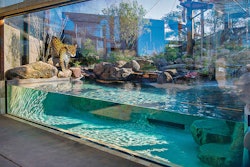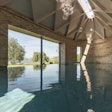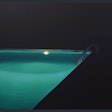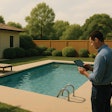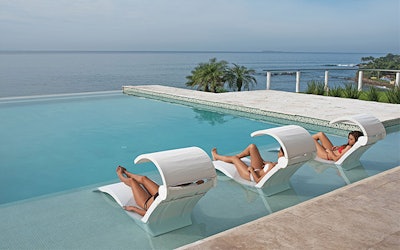
{bglink 4680}The demand for fiberglass pools overall has more than doubled in the past decade. But more recently — within the last five years — there's been a major trend toward tanning ledges integrated into the pool design.
In just the past year, two thirds of the pools we manufactured and installed at River Pools have included a wide ledge area. We believe this is partially because we intentionally developed our pool designs with integrated tanning ledges, which positioned us to meet the growing consumer demand.
RELATED: Demand for Fiberglass Doubles — Experts Explain Why
Why the rise in popularity? It adds an entirely different dimension to how people use their pools. A broad shelf with 6 to 10 inches of water facilitates a variety of activities that a wide range of customers love. In fact, many people tell us it's their favorite part of their pool.
For one thing, tanning ledges are great for dogs. Many clients have told us their dogs like to hang out on the ledge, swim out into the body of the pool and then swim back. It's great exercise for the dog and it's fun for the humans, too.
It also provides a fun and safe area for smaller kids. Of course they have to be supervised, but they can hang out on the ledge, splash around and fully engage. When ready, they can venture into the pool via the steps that come off the ledges.
We've found that it's adults who enjoy the biggest advantages of tanning ledges on fiberglass pools, as it opens up an entirely new dimension of pool ownership. With a traditional pool you're either in or you're out. Our clients find tanning ledges appealing because they want the option to engage the water without being fully immersed. In that sense, tanning ledges provide a relaxing, refreshing hybrid space.
Add in the social dimension, where couples or friends now can enjoy the pool together in a different way, and it becomes an easy sell.
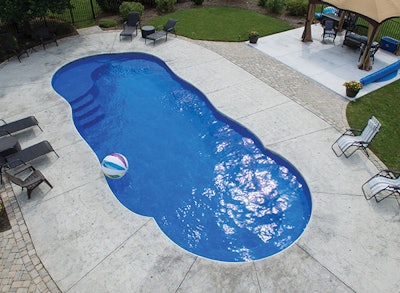 Tanning ledges offer much in the way of versatility. They're great for dogs, children and adults alike.
Tanning ledges offer much in the way of versatility. They're great for dogs, children and adults alike.
LEDGE EVOLUTION
Looking back, the first versions of tanning ledges in fiberglass pools were actually separate vessels that were attached to the main pool and usually separated by a small dam wall. They were more like attached kiddie pools, which was all well and good, but they added as much as $15,000 to the cost of the project. That was far too much for most homeowners, even the ones who really liked the concept.
Even though we continue to manufacture and install separate tanning ledges, this has really opened the door for integrated tanning ledges which add little or no cost to the price of the pool.
RELATED: The 6 Most Popular Pools of 2017 (So Far)
BIG ENOUGH
Since they tend to be a social area, it's not surprising that the ledges themselves have become larger. Much of that has to do with the popularity of loungers placed on the steps, which have become almost as popular as the ledges themselves. Our customers have told us that even when they're not using the pool, they love the inviting look of the lounger in the shallow water.
To accommodate the chaise lounges and other types of furniture, the ledge should be at least 7 feet by 8 feet across the width of the pool. Look at the blueprint of many models and take into account the steps that descend from the ledge into the body of the pool. The ledge and steps take up a considerable portion of the pool area, which is why we make ledges optional on many models. Some ledges are not that wide and work more as a glorified top step, but we've found that the larger shelves are becoming more popular.
Regardless of the size, we put a non-skid texture on our ledges, steps and floors. Our technicians hand-apply the textured surface to our molds, making the end product incredibly attractive and durable. We've found that people like the safety aspect of the non-slip surface, which enables them to enjoy the pool worry-free.
INSTALLATION SUPPORT
 Photo courtesy of San Juan Fiberglass Pools. (Great Lakes model)
Photo courtesy of San Juan Fiberglass Pools. (Great Lakes model)
As I mentioned, our company manufactures shells, but we actually began as an installer in 2001. We expanded into the manufacturing side in 2013 and committed from the onset to design and build our pools from the perspective of the installer. Consequently, we're always looking for a better way to build and install pools with tanning ledges. We've found that the two keys to success are ensuring the tanning ledges are properly supported and properly leveled with the rest of the pool.
Leveling the pool is the part that requires the most finesse and experience. Most tanning ledges will, because of their sheer weight, naturally sag around an inch to an inch and a half. We raise the ledge so it's level with the rest of the pool. We then support it with a set of cinderblock piers installed along the outside of the ledge.
RELATED: 5 Common Fiberglass Concerns, Addressed
It is important not to place the piers in the center of the ledge, as we want the load to be carried by the outer perimeter, where the pool is the strongest. Find the point where the wall around the outside of the ledge transitions to the floor. You want that point, right on that radius, sitting on the piers. The size of the ledge determines how many piers you need. For most installations, it's an average of two or three every 5 to 6 feet.
After our early installations, even though our tanning ledges were level and properly supported, we received a few comments from our clients saying the space beneath the ledges felt somewhat hollow. We had been filling the entire void beneath the tanning ledge with the same stone we used for backfilling.
After exploring our options, we decided to make two changes. First, we increased the thickness of the core material we fiberglass into the bottom of the tanning ledges. We had always covered the entire bottoms of our steps, benches and tanning ledges with a honeycomb core material, but increasing the thickness gave the features a more solid feel.
Second, we began backfilling beneath the ledges with grout (composed of sand, cement and water) brought in by a ready-mix concrete truck. The addition of the new backfill, in conjunction with our thicker core material, gives us a finished product that feels more monolithic and gives the consumer the solid feel they expect when spending their hard-earned money on an inground fiberglass pool.
RELATED: Success Beyond the Pool
FUN AESTHETICS
Tanning shelves also give us an opportunity to create some interesting and fun aesthetic touches.
Early on in our work with tanning ledges, we discovered they were very difficult to light with the traditional installation of pool lights. They're so shallow that virtually no light, when installed at typical depths, spills onto the ledge. The result: a shadowy area on the ledge that many of our customers didn't like.
Fortunately, the smaller LED lights solved that problem, as they can be installed at much shallower depths. We've found that at least one pool light should be installed in the proximity of, and at the same depth as the tanning ledge. We typically suggest clients have at least three lights on tanning ledge pools, with one light dedicated to the ledge.
We also like to install bubblers or vertical plume jets in the floor of the shelves. We use small jets that break the surface by 8 to 10 inches. They create a fountain-style feature in the pool. Kids love to play with them, and they look great when the pool's not in use, especially when installed with LED lights.
Comments or thoughts on this article? Please e-mail [email protected].

























